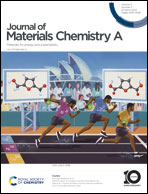Synergistic optimization of mechanical and photovoltaic properties in ternary organic solar cells from a two-donor polymer blend†
Abstract
Using multiple donor polymers is a simple means to broaden the absorption range of organic solar cells (OSCs). Yet, achieving improved photovoltaic and mechanical properties in OSCs based on dual polymers has not met with success so far. Here, we address this challenge by introducing a low-cost and 2D semi-paracrystalline conjugated polymer PTQ10 as the second polymer donor to the benchmark PM6:N3 blend. Both improved photovoltaic and mechanical performances were realized in the optimized PM6:PTQ10:N3-based OSCs at a polymer blend ratio of 4 : 1. The influence of the second polymer on the mechanical and photovoltaic properties of the ternary blend system was examined via grazing-incidence X-ray scattering and thin-film mechanical measurements, offering an in-depth understanding of the inner relationships between the film structure and mechanical properties in such ternary blend systems. Crucially, we were able to predict the composition dependence of the elastic modulus via a theoretical model for these ternary blend films based on dual-donor polymers. This work provides a new guide for fabricating highly efficient and stretchable solar cells from multiple polymer blends.

- This article is part of the themed collection: Journal of Materials Chemistry A HOT Papers


 Please wait while we load your content...
Please wait while we load your content...